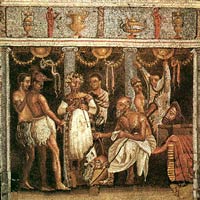|
Caesar's consulship
 Women
Women
Women living in the Roman Empire were treated quite differently than the men were. However, that doesn't mean they didn't have an interesting and active life. They were valued for their role in society. In fact, the women in Rome were treated much better than they were in many other societies, such as the Greeks.
According to Roman law, all women had to have a male custodian. In childhood, boys and girls were both under the guardianship of the eldest man in the family, just as children today are taken care of by their parents. This man had the power of life and death over those in his family. Even after the women were married, sometimes this guardianship was not passed to the husband. The law eventually changed and they no longer had to have a male guardian.
When a girl reached the age of twelve, she was allowed to marry. The young girl's father would generally arrange the marriage. He would choose the husband based upon how much help his family would be politically. The bride could refuse only if she could prove that the man was morally unfit to be her husband. There were three different types of marriages in Rome. One, which resembled the selling of the bride, was called coemptio. With this, the bride was required to adopt the religion of her new family and she was no longer considered part of her father's family. Another kind of marriage was more informal. The bride still considered herself part of her father's family. She was allowed to keep her religion and her father's family kept legal custodianship. The third kind of marriage was called uses. It was caused simply by the man and woman living together.
During the early days of Rome, men could only divorce a woman for certain reasons. If the woman slept with other men while married, poisoned her husband's children, or counterfeited his keys, the husband was granted a divorce. This did change as time went on. Later, childlessness of the couple as well as political and personal reasons were added to the list of reasons for divorce. If a divorce did occur, the children always lived with their father.
The daily life of Roman women depended on their level of income. Numerous male and female slaves often attended wealthy women. This freed them up from many daily household tasks. They spent their time visiting, shopping, attending festivals and recitals, and supervising the education of their children. The lower class women, with less money and social standing, had to work for a living, often in the fields and around the house.


|